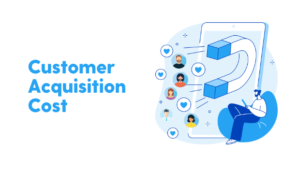Conversion Rate Optimization (CRO) is a systematic process of improving the performance of a website or landing page by increasing the number of actions taken by visitors, such as making a purchase, filling out a form, or subscribing to a newsletter.
CRO can involve many tactics, such as A/B testing, user research, heat mapping, analytics, etc. The goal is to identify areas of improvement and make changes that will impact conversions.
For example, imagine a website that sells handmade crafts. The website owner wants to increase the number of visitors who purchase items on the site. Through customer journey mapping, the owner might discover that the site’s shopping cart is confusing to use or that the “Add to Cart” button is not prominently displayed. By making changes to the cart and button, such as simplifying the design and making the button more visible, the owner might see an increase in the conversion rate of visitors who complete a purchase.
In summary, CRO is a process of continuous testing and improvement that is aimed at increasing the number of desired actions taken by users/prospects/leads. It is a data-driven approach that analyzes user behavior, tests different elements in the customer journey, and makes changes based on the results.
Why is CRO Important
Conversion Rate Optimization (CRO) is important for several reasons, such as:
- Drive incremental revenue: Optimizing your website or landing pages can increase conversions and generate additional revenue for the same amount of money spent on marketing. Read more – Marketing Analytics
- Arrest customer drop-off: CRO helps you understand where your website is losing users and take remedial actions to keep them engaged and moving forward in the process.
- Culture of experimentation: By using data and experimentation to make product decisions, you can improve your outcomes and stay competitive in your industry. Read more – SWOT Analysis
- Create great user experience: CRO helps you design an exceptional user experience for your customers, based on data and insights about their behavior and preferences.
- Test before you commit: By testing new features and designs on a small sample of users before a full-fledged rollout, you can mitigate revenue loss risks and ensure that changes will have a positive impact.
- Leverage business knowledge: By understanding your website or app’s business context and goals, you can go beyond out-of-the-box CRO tools and create a sustainable impact.
Read more: Customer Data Platform
How CRO results Benefit Different Teams
CRO can drive growth for a business by helping functions and teams in a variety of ways, including:
| Team | Benefit |
| Marketing |
|
| Product Team |
|
| Merchandizers |
|
| Sales |
|
| Customer Service |
|
| Finance |
|
By working together and sharing insights and data, different teams can collaborate to optimize and achieve better results.
Also, read:
13 Tips to Boost CRO
Measuring and analyzing CRO efforts through analytics can help identify improvement areas and track optimization efforts’ success. Here are 13 tips and techniques to increase conversion rates:
- Set up conversion tracking: To measure CRO, it is important to set up conversion tracking in web analytics tools such as Google Analytics. This will allow you to track key metrics such as the number of conversions, conversion rate, and the value of conversions.
- Identify key performance indicators (KPIs): Identify the key performance indicators (KPIs) that are most relevant to your business and that will help you track your CRO efforts’s success. Common KPIs include conversion rate, bounce rate, time on site, and revenue.Also, read:
- A/B testing: This involves creating two versions of a webpage, with small variations in design, layout, or copy. The different versions are then shown to different groups of visitors, and the one that performs better in terms of conversions is chosen as the winner.
- Landing page optimization: This involves analyzing and optimizing the elements of a landing page to improve the user experience and increase conversions. This can include testing different headlines, images, and calls to action, as well as optimizing the layout and design of the page.
- Use heat maps and session recordings: Use heat maps and session recordings to track where visitors are clicking on a webpage and which elements they are interacting with. This information can be used to optimize the page’s layout and design and ensure that key elements, such as the call to action, are prominently displayed.
- User research involves conducting surveys, interviews, or usability tests to gain a deeper understanding of user behavior and preferences. This information can be used to identify improvement areas and make website changes that will impact conversions.
- Analyzing web analytics data: Analyzing web analytics data such as bounce rate, session duration, goal completion, and more, can give insights about the behavior of visitors on your website and identify the issues that causing visitors to leave the website without taking any action.
- Personalization: With the help of tools and technologies, it is possible to personalize the website experience for different visitors based on their behavior and demographics. This can help to improve the user experience and increase conversions.
- Multivariate testing: This technique is similar to A/B testing, but involves testing multiple elements and variations at once. This can help to identify the best combination of elements for a webpage and achieve the highest possible conversion rate.
- Monitor the funnel: Monitor the funnel where the visitors go through on your website, such as the home page, product page, checkout page, and so on. This can help you to identify bottlenecks and drop-off points in the funnel and make changes to improve the user experience and increase conversions.
- Use segmentation: Segment your data by different variables such as traffic sources, device, geography, and more. This will help you to identify patterns and trends in your data and make more informed optimization decisions.
- Analyze user behavior: Analyze user behavior data such as clicks, scrolls, and mouse movements to understand how visitors interact with your website. This can help you to identify areas of improvement and make changes that will have the biggest impact on conversions.
- Measure the impact of changes: Measure the impact of changes made to your website by comparing pre and post-change data. This will help you see the changes’ effect and identify the elements driving the most conversions.
Please note that these are just examples of CRO techniques and there are many more ways to improve conversion rates. It’s important to use a combination of different techniques and to monitor and optimize the website continuously.
Also, read:
eCommerce Conversion Rate Optimization
10 tips to boost CRO for your eCommerce business:
- Use clear and prominent calls to action (CTAs) throughout your website.
- Optimize your product pages for conversions by including high-quality images, detailed product descriptions, and customer reviews.
- Use A/B testing to experiment with different elements of your website, such as headlines, images, and layout.
- Offer free shipping or other incentives to encourage customers to complete their purchase.
- Make it easy for customers to navigate your website and find the products they’re looking for.
- Implement a robust and user-friendly search function to help customers find products quickly.
- Use retargeting ads to bring customers who have abandoned their shopping carts back to your website.
- Make sure your website is mobile-friendly, as more and more customers are making purchases on their mobile devices.
- Implement a live chat feature to provide customers with real-time assistance as they shop.
- Use trust signals such as SSL certificates, trust badges, and money-back guarantees to build customer trust.
A positive user experience (UX) can lead to increased customer satisfaction, trust and loyalty, which can in turn result in increased conversion rates. A poor UX can lead to customer frustration and abandonment, resulting in lower conversion rates.
CRO – Lead Generation
Lead generation is the process of attracting and capturing the contact information of potential customers. This information can then be used to nurture and convert those leads into customers. Lead generation is an important part of conversion rate optimization because it allows businesses to target their marketing efforts to a specific audience, increasing the chances of converting leads into customers.
10 best practices for generating and converting leads
- Create a lead magnet such as an e-book, webinar, or free trial to attract potential customers and capture their contact information.
- Use forms and landing pages to collect lead information in a user-friendly way.
- Use SEO and PPC to drive traffic to your website and increase lead generation.
- Use email marketing to nurture leads and build a relationship with them.
- Use retargeting ads to bring leads back to your website and increase the chances of conversion.
- Use personalization to tailor your marketing efforts and increase the relevance of your offers to each lead.
- Use A/B testing to experiment with different elements of your lead generation and conversion efforts and determine which elements lead to higher conversion rates.
- Use lead scoring to prioritize your leads based on their level of engagement and likelihood to convert.
- Use analytics and reporting to track the performance of your lead generation and conversion efforts, and make data-driven decisions to improve them.
- Use a CRM to store and manage lead information and to automate lead nurturing and conversion efforts.
CRO – Funnel Optimization
The marketing and sales funnel visually represents a customer’s journey from being aware of a product or service to the final purchase. The funnel has several stages: awareness, interest, consideration, intent, and conversion. Conversion rate optimization (CRO) is the process of improving the performance of the funnel at each stage to increase the number of customers who move through the funnel and make a purchase.
Techniques for optimizing each stage of the funnel
| Funnel Stage | Techniques | |
| Awareness | SEO, PPC, Social media marketing, Influencer marketing | |
| Interest | Compelling headlines and images, video marketing, landing pages | |
| Consideration | Detailed product information, customer reviews, comparison charts, retargeting ads, lead magnets | |
| Intent | Email marketing, personalization, abandoned cart emails | |
| Conversion | CTAs, trust signals, streamlined checkout process, post-purchase email campaigns |
Mobile Optimization & Conversion Rates
Mobile optimization is the process of making a website or application mobile-friendly and easy to use on a mobile device. With the increasing number of people using smartphones and tablets to access the internet, mobile optimization has become crucial for businesses to ensure that their website is accessible and easy to use on all devices. A mobile-friendly website can lead to increased customer engagement, improved user experience, and higher conversion rates.
10 Best Practices for Mobile-Friendly Design and Functionality
- Use a responsive design that adapts to the screen size of the device being used to access the website.
- Use a simple and easy-to-use layout that is easy to navigate on a small screen.
- Use large and easy-to-tap buttons for easy navigation and interaction.
- Use finger-friendly design elements like larger text and buttons to make it easy to use on a touch screen.
- Use high-resolution images and videos that look good on a small screen.
- Optimize page loading speed, as slow-loading pages can lead to customer frustration and abandonment.
- Use mobile-specific features such as click-to-call and location-based mapping.
- Use A/B testing to experiment with different mobile design elements and determine which elements lead to higher conversion rates.
- Use analytics to track your mobile website’s performance and identify improvement areas.
- Continuously monitor and analyze mobile metrics such as bounce rate, time on site, and conversion rate to identify areas for improvement.
CRO Tools
| Category | Tool Name |
| UX (User Experience) | Crazy Egg, UserTesting, Hotjar, Optimal Workshop, UserZoom, Fullstory, Qualaroo, Survey Monkey, InVision |
| Lead Generation | Unbounce, Leadformly, OptinMonster, Hello Bar, Leadpages, LeadSquared, Leadformix, Leadformly, Leadpages |
| Funnel Optimization | Google Analytics, Mixpanel, Optimizely, VWO, KISSmetrics, Heap Analytics, Amplitude, ClickTale, Piwik, HubSpot |
| Mobile Optimization | Google Analytics, Mixpanel, Optimizely, VWO, KISSmetrics, Mobile Analytics, Mobile Action, Mobile App Analytics |
One issue with out-of-the-box tools or point solutions is that they fail to holistically measure and optimize conversions specific to your business. Identifying the most important KPIs and setting up conversion tracking are the two essential steps to get started. If your revenue is more than $15 million per year and you don’t have a data team, then you should consider a data solution provider who can set up a single source of truth for your data and then track, visualize, and analyze your data to drive growth.
Read more – Data Warehousing
Conclusion
Conversion rate optimization is a crucial aspect of driving growth for any business. It’s about understanding your customers’ behavior and finding ways to improve their journey on your website or app. As a premier data platform solutions provider, we at Saras Analytics empower leading international brands to optimize their conversion rates for their entire business operations. Our team of experts uses cutting-edge technology and data-driven insights to help you understand your customers better.
Our process includes managed data operations and growth analytics:
- Analytics Health Check: We’ll evaluate your current analytics setup and identify any areas for improvement.
- Research & Recommendation: We’ll conduct research to understand your customers and make recommendations on how to optimize their journey.
- Experimentation: We’ll set up and run A/B tests to validate our recommendations and make data-driven decisions.
- Continuous Improvement: We’ll monitor your analytics regularly and make adjustments as needed to ensure ongoing optimization.
If you’re ready to take your conversion rate optimization to the next level and drive growth for your business, contact us today to schedule a consultation and learn more about how we can help.













